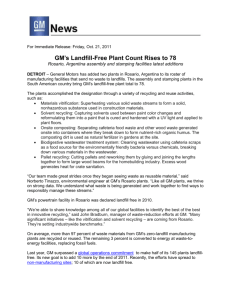1_FOOTPRINT_test
advertisement
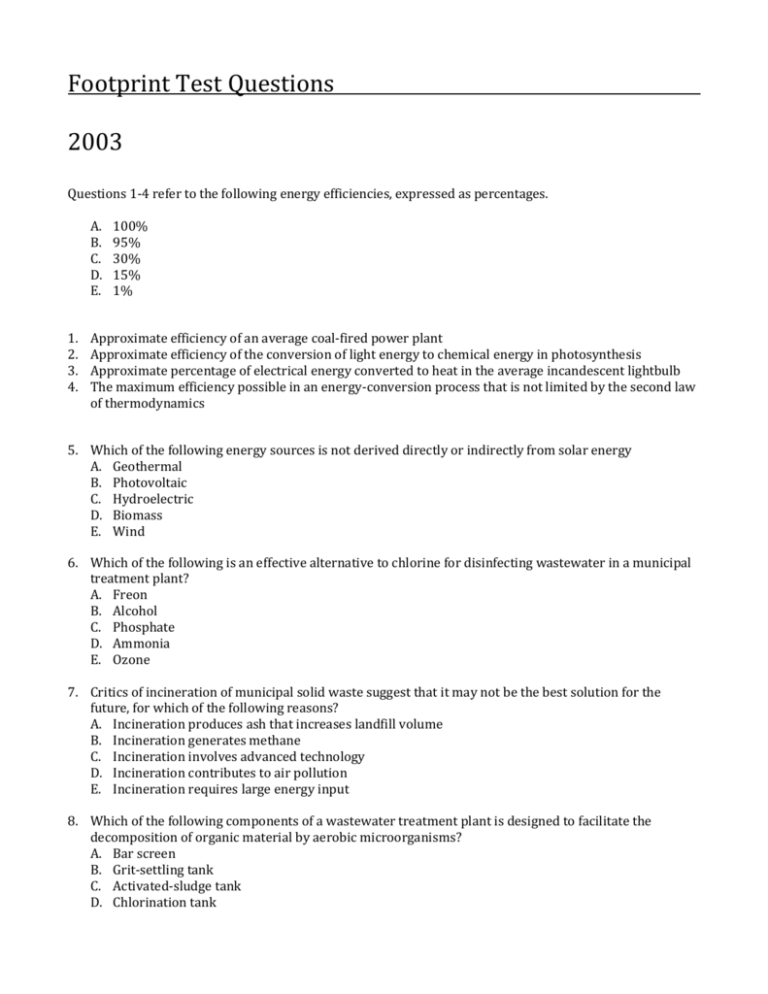
Footprint Test Questions 2003 Questions 1-4 refer to the following energy efficiencies, expressed as percentages. A. B. C. D. E. 1. 2. 3. 4. 100% 95% 30% 15% 1% Approximate efficiency of an average coal-fired power plant Approximate efficiency of the conversion of light energy to chemical energy in photosynthesis Approximate percentage of electrical energy converted to heat in the average incandescent lightbulb The maximum efficiency possible in an energy-conversion process that is not limited by the second law of thermodynamics 5. Which of the following energy sources is not derived directly or indirectly from solar energy A. Geothermal B. Photovoltaic C. Hydroelectric D. Biomass E. Wind 6. Which of the following is an effective alternative to chlorine for disinfecting wastewater in a municipal treatment plant? A. Freon B. Alcohol C. Phosphate D. Ammonia E. Ozone 7. Critics of incineration of municipal solid waste suggest that it may not be the best solution for the future, for which of the following reasons? A. Incineration produces ash that increases landfill volume B. Incineration generates methane C. Incineration involves advanced technology D. Incineration contributes to air pollution E. Incineration requires large energy input 8. Which of the following components of a wastewater treatment plant is designed to facilitate the decomposition of organic material by aerobic microorganisms? A. Bar screen B. Grit-settling tank C. Activated-sludge tank D. Chlorination tank E. Ultraviolet-light array 9. The combustion of one gallon of automobile fuel produces about 5 pounds of carbon (in CO2). Two autos are making a trip of 600 miles. The first auto gets 20 miles per gallon, and the second gets 30 miles per gallon. Approximately how much less carbon (in CO2) will be produced by the second auto on this trip? A. 300 lbs B. 150 lbs C. 100 lbs D. 75 lbs E. 50 lbs 10. Which of the following best illustrates the concept of the tragedy of the commons? A. Destruction of landscape by surface mining on private land B. Selective harvesting of trees by a timber company in a national forest C. Legislation of catch limits to avoid depletion of fish stocks in a shared lake D. Inadvertent destruction of beneficial species while attempting to control pests E. Depletion of an aquifer by regional farmers 11. In the United States, most municipal solid waste is disposed of by A. Composting B. Recycling C. Incineration D. Ocean dumping E. Landfilling 12. If wastewater treatment plant effluent that contains nitrates and phosphates is allowed to flow into a body of water, which of the following may result? A. Chlorination B. Decomposition C. Eutrophication D. Oxygenation E. Methylation 13. An advantage of recycling aluminum rather than disposing of it in landfills is that aluminum can be A. Produced from recycled metal using much less energy than is required for its production from aluminum ore B. Produced from ore that is chemically reactive and dangerous to transport, store, and process C. Produced from ore that is scares and found primarily in remote, inhospitable regions at high latitudes D. Absorbed by plants and then biomagnified in both terrestrial and aquatic food chains E. Leached from landfills in the form of Al3+ ions that could increase the pH of lakes and streams 14. Integrated waste management employs all of the following EXCEPT A. Using refillable soft-drink bottles B. Using disposable diapers instead of cloth diapers C. Using reusable canvas bags instead of plastic or paper bags D. Using tires for the construction of artificial reefs E. Redesigning automobiles to replace steel parts with aluminum and plastic parts 15. If the annual consumption of petroleum in the United States is about 23 barrels per capita, the total annual consumption of petroleum in the United States is closest to A. 12 million barrels B. C. D. E. 240 million barrels 2 billion barrels 6 billion barrels 10 billion barrels 16. Photosynthesis is the major source of which of the following gases in Earth’s atmosphere? A. CO2 B. H2O (water vapor) C. O2 D. H2 E. N2 17. The chart above compares the daily water use per person to the price of water in selected countries. Which of the following conclusions can be correctly drawn using only the data in the chart? A. Water use and water price are directly proportional. B. Increased water use causes prices to decline C. Increased prices cause water use to decline D. Increased water use is generally correlated with lower water prices. E. Water is more plentiful in the United States and Canada than in the other countries. 1998 Questions 1-4 refer to the following methods of solid-waste disposal and treatment. A. B. C. D. E. Sanitary landfill Incineration Discharge to sewers, streams, and rivers Chemical treatment Biological treatment 18. Which method reduces the volume of waste but could release toxic emissions into the atmosphere? 19. Which method is used most frequently in the United States today? 20. Which method introduces microorganisms to break down hazardous organic compounds? 21. Which method would be best suited for neutralizing the acidic components of waste? The following questions refer to the following concepts related to energy. A. B. C. D. E. 22. 23. 24. 25. Heat flow Kinetic energy Potential energy First law of thermodynamics Second law of thermodynamics Matter in motion has energy. Energy is transferred from one object to another as the result of a temperature difference An energy transformation occurs and results in increased disorder. The mount of energy in an isolated system stays constant. The following questions refer to the following energy sources. A. Biomass B. Wind C. Tidal energy D. Nuclear fission E. Sunlight 26. 27. 28. 29. The source that produces long-lived hazardous wastes The source that is converted directly into electrical energy by photovoltaic cells The source whose use is a direct cause of deforestation The source that is not renewable. 30. Environmentalists oppose the mining of Antarctic mineral resources because A. Territorial claims to Antarctica are unresolved B. The existence of valuable mineral deposits in the Antarctic environment is unlikely C. The Antarctic environment is fragile and extremely vulnerable to the disturbance that would accompany development D. Currently known world reserves of important metals and oil are considered inexhaustible E. The demand for minerals is expected to decline as the world’s nations become more industrialized 31. All of the following are considered toxic metal pollutants EXCEPT A. Cadmium B. Chromium C. Lead D. Mercury E. Potassium 32. Which of the following metals is considered an energy resource? A. Uranium B. Cobalt C. Mercury D. Copper E. Palladium 33. Of the following, which constitutes the greatest percent of domestic use of water in the United States? A. Flushing toilets B. Drinking C. Cooking D. Washing dishes E. Washing clothes 34. If an incandescent lightbulb used for lighting has an efficiency rating of 5 percent, then for every 1.00 joule of electrical energy consumed by the bulb, which of the following is produced? A. 1.05 joules of light energy B. 1.05 joules of heat energy C. 0.95 joule of light energy D. 0.05 joule of light energy E. 0.05 of heat energy 35. Which of the following would most likely have the greatest positive impact on the quality of the natural environment worldwide? A. Discovery of new reserves of fossil fuel in coastal areas B. Increased agricultural production on marginal desert lands C. Increased life expectancy in more developed nations D. Increased reliance on food from ocean ecosystems E. Stabilization or reduction of the size of the human population 36. All of the following substances are derived from petroleum EXCEPT A. Asphalt B. DDT C. Cellulose D. Polystyrene E. Nylon 37. Of the following, which is the most serious immediate problem associated with sanitary landfills? A. Generation of CO2 gas B. Leachate contamination of groundwater C. Release of disease organisms D. Incomplete degradation of wastes E. Compaction and settling 38. There are various stages in the formation of coal as heat and pressure are increased and moisture content is decreased. These stages, in order, are A. Bituminous, peat, lignite, anthracite B. Peat, lignite, bituminous, anthracite C. Peat, lignite, anthracite, bituminous D. Lignite, bituminous, anthracite, peat E. Anthracite, bituminous, peat, lignite 39. Which of the following correctly orders the methods of solid-waste management in terms of energy required? Least energy Most Energy A. Reuse B. Recycle Recycle Reuse Reduce Reduce C. Recycle D. Reduce E. Reduce Reduce Reuse Recycle Reuse Recycle Reuse 40. In the removal of a pollutant from wastewater, which of the following is true of the cost per unit of pollutant removed? A. It decreases as the toxicity of the pollutant increases B. It decreases as tie passed before remediation increases C. It increases as the concentration of the pollutant decreases. D. It increases as the volume of the wastewater decreases. E. It does not change over time or with concentration of pollutant. 41. In the United States, the largest single component of municipal solid waste is A. Glass B. Paper C. Food scraps D. Wood and other construction debris E. Plastic 2008 Questions XX through XX refer to the following. A. Safe Drinking Water Act B. Clean Water Act C. Comprehensive Environmental Response Compensation and Liability Act (CERCLA) D. Resource Conservation and Recovery Act E. Toxic Substances Control Act 42. Requires minimum safety standards for community water supplies 43. Mandates the restoration and maintenance of the chemical, physical, and biological integrity of the nation’s waters 44. Establishes cradle-to-grave tracing of hazardous waste Questions XX through XX refer to the substances listed A. B. C. D. E. 45. 46. 47. 48. Asbestos Radon Lead Carbon Monoxide Formaldehyde Found in old plumbing pipes and fixtures and some ceramic glazes Composed of fibers known to cause lung disease Emitted from most manufactured building materials and furniture Colorless, odorless gas that is a naturally occurring decay product of uranium 49. Of the following countries, which has the largest proven reserves of strategic metals such as manganese, chromium, and platinum? A. South Africa B. C. D. E. Japan Saudi Arabia The United States France 50. In 2007 in the United States there were approximately 480 cars for every 1,000 people. The total number of cars in the United States in 2007 was closest to A. 150,000 B. 30,000,000 C. 150,000,000 D. 300,000,000 E. 3,000,000,000 51. Of the following strategies to decrease the landfill volume of packaging material from food and other consumer products, the most energy efficient is A. Recovering plastic packaging material from the waste stream and recycling it B. Recovering metal packaging material from the waste stream and recycling it C. Limiting the size of individual beverage containers made form metal, glass or plastic D. Using more packaging materials that are manufactured from raw materials that are renewable E. Promoting the use of reusable containers for consumer goods 52. Which of the following best describes the first law of thermodynamics? A. Energy always changes from a more useful, more concentrated form to a less useful, less concentrated form. B. In a closed system of constant mass, the energy involved in any physical or chemical change is neither created nor destroyed, but merely changed from one form to another. C. Heat always flows from a hot body to a cold body D. Entropy of a system increases as the state of disorganization in the system increase. E. In a reversible process, the entropy of the system is constant, whereas in an irreversible process, the entropy of the system increases. 53. Pollution is considered an external cost when A. It has harmful effects borne only by the people who purchase the products that cause the pollution B. The cost to the environment is not reflected in the price of the products that produce the pollution C. It has a significant impact on the consumer’s decision to buy a product that pollutes D. It is a hidden cost that would result in a greater demand for the product if the consumer were aware of the hidden cost E. It is produced in the external environment by a malfunction in the operation of the product 54. Which of the following best illustrates point-source pollution? A. Toxic sediments in the delta of a major river B. Increase in NOx in a traffic-clogged city C. Dust blowing off unpaved roads D. Smoke emitted from forest fires E. Smokestack emissions from a large smelting company. 55. Most municipal solid waste in the United States is disposed of in A. The oceans B. Sanitary landfills C. Deep wells D. Open dumps E. Abandoned mines 56. Which of the following terms applies to the economic approach of including external costs in the price of goods and services? A. Optimal-cost pricing B. Cost-benefit pricing C. Full-cost pricing D. Green pricing E. Subsidized pricing 57. Which of the following would encourage recycling? A. Decreasing government purchases of recycled materials B. Decreasing subsidies for recycling C. Decreasing taxes on resource-extracting industries D. Decreasing taxes on recycled material E. Decreasing fees for using landfills 58. Sustainable use of forests in the United States would likely be encouraged by A. Cutting small groups of medium- and large- sized trees in uneven-aged forests B. Clear-cutting old-growth forests to allow for secondary succession C. Allowing road building in wilderness areas so that older, clear-cut forests have time to regenerate D. Logging on steep slopes in designated wilderness areas E. Enforcing all provisions of the Resource Conservation and Recovery Act (RCRA) 59. A home uses ten 100-watt lightbulbs for five hours per day. Approximately how many kilowatt-hours of electrical energy are consumed in one year by using the lightbulbs? A. 365 B. 1,825 C. 5,000 D. 10,500 E. 365,000


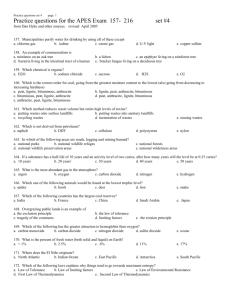

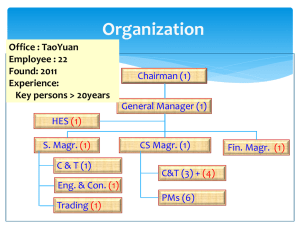
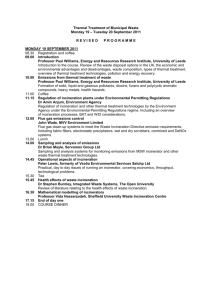
![School [recycling, compost, or waste reduction] case study](http://s3.studylib.net/store/data/005898792_1-08f8f34cac7a57869e865e0c3646f10a-300x300.png)
